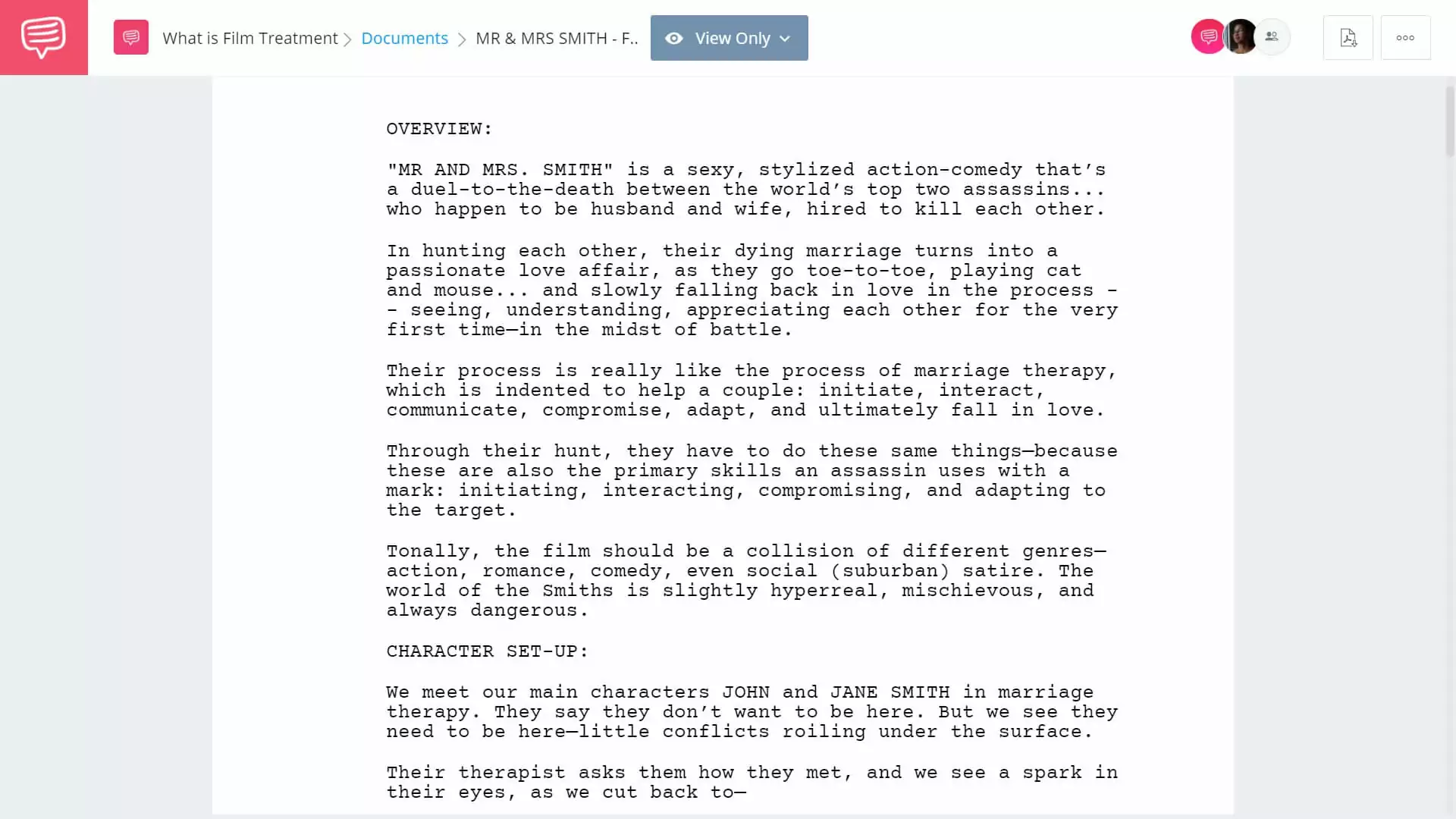Whenever you read a full-length screenplay, it is important to understand all of the steps that led to the final draft of that script. Stories are often changed and workshopped long before they are written into a screenplay. The pre-writing phase of a screenplay is essential to many writers and a fundamental device used is the film treatment. A treatment is utilized for various reasons and can be a key component to developing the seeds of an idea. So, what is a treatment in film? Let’s unpack the definition of a film treatment and why they are important for all writers to understand.
Watch: Anatomy of a Screenplay — Ultimate Guide
What is a treatment in film?
First, let’s define film treatment
If you take a look at some film treatment examples in the industry, you’ll notice they vary in length, content, and even format. While there isn’t necessarily a definitive template for treatment, understanding the foundational definition of a film treatment will help you write an effective one.
FiLM TREATMENT DEFINITION
What is a film treatment?
A film treatment is a summary of a film or television show. It should communicate all of the essential scenes, themes, and tone of the project to entice or pitch to buyers and producers into reading, developing, or even purchasing your idea. Film treatments are also referred to as story treatments, script treatments, and movie treatments.
What are the key elements of a treatment?
- Title
- Name and contact information
- Logline
- Key characters
- Summary of the story
- Conveys themes and tone
What is a treatment in film?
Why do film treatments matter?
Treatments are extremely effective at saving time for both you as the screenwriter and those reading the treatment. Learning how to write a film treatment is an essential skill for any writer looking to break through in the industry. Not every writer has time to write a full-fledged screenplay or pilot. Writing a treatment is a great way to get your ideas and story down on paper and have something physical to present. It is also effective at gauging your interest in the story and whether or not it has the potential to become a full screenplay.
Getting potential producers or executives to read a script treatment is a lot more achievable than getting them to read a full feature length screenplay. For this reason, they’re also great at providing shorter reads to gain and gauge interest in a story. Understanding how to write a film treatment will make you a more effective and efficient writer.
Film treatment formatting
Reasons to write a film treatment
As a writer, there are various reasons why you might want to write a film treatment. The first reason would be to create a detailed summary of a film or television show that serves as a shareable plan for the screenwriter’s unwritten screenplay. This is great to gauge the interest in an idea before dedicating time and energy into writing a full length script. This is an early step and an essential part of StudioBinder’s TV Writing and Development Masterclass.
Ideas in television are plentiful, but are rigorously tested among the audience's interest. The episodic format of television entails numerous ideas being pitched and thrown around. Rather than writing full episodes, treatments allow writers to summarize and pitch episode ideas especially in the writers room.
Knowing how to write a treatment for television is an essential skill for any television writer. Check out our video in which we break down the steps to writing a television show treatment.
How to Write a TV Show Script Treatment • Get the Entire Masterclass Series
On the other hand, you may already have a full screenplay written out. However, getting others to read a full length screenplay can be an ambitious request. Writing a treatment that deconstructs and distills your screenplay into a more digestible summary will help you get others to read it.
Beyond the benefit of the reader, treatments are also worth writing for the sake of the writer. Treatments often serve as general blueprints of a story’s plot, structure, and framework. This is helpful to have when undertaking rewrites of a script or having other writers hop on board a project. For the writer, treatments also serve as a diagnostic tool that can help you identify problems in your story and work on them.
Once you’ve decided to get started and write a script treatment, first check out our article on how to write a film treatment in which we breakdown various film treatment examples that demonstrate key components of a great film treatment.
Related Posts
Film Treatment Examples
E.T. The Extra-Terrestrial 2 (1982)
One of the best ways to learn how to write a treatment is to take a look at treatments from major motion pictures. Consider this film treatment example from Steven Spielberg’s vision for a sequel to one of the best sci-fi movies E.T. the Extra-Terrestrial.
In it, we learn the value that a movie treatment has in deciding NOT to make a film. Spielberg and screenwriter Melissa Mathison wrote a treatment for the potential sequel only to decide that it wouldn't work. We've imported the treatment into StudioBinder's screenwriting software so you can download and read it yourself. Just follow the link.
Writing a movie treatment enables others to give you feedback on your idea while also allowing you to recognize holes in your story’s concept. This can be important in deciding whether or not a story is worth taking into Production.
Film Treatment Examples
The Shining Film Treatment
Many auteur directors have to develop the vision of a story early on. This can be especially important when adapting a story for cinema as is the case of one of the best Kubrick films The Shining. For Stanley Kubrick, this movie treatment example demonstrates his early visions of the film and how most of it saw it through to the final cut. Let’s take a look at the auteur film director’s treatment example of The Shining.
By choosing to take artistic direction by straying from the book the film was adapted from, Kubrick began to explore his own version of The Shining early on by writing this film treatment.
Film Treatment Examples
Mr. and Mrs. Smith Film Treatment
Directors and screenwriters like Kubrick and Spielberg often have the luxury of breaking structure and writing their movie treatments how they see fit. This is not always the case for screenwriters creating a film treatment. So let’s take a look at the treatment for Mr. and Mrs. Smith that utilizes a more organized structure that is more common for aspiring screenwriters.
By breaking down the screenplay treatment into overview, character set-up, and story, the screenplay treatment is clear and direct. While it may not fit a concise one-page film treatment, it does effectively and efficiently cover all the necessary material.
Related Posts
Movie Treatment Examples and Tips
What not to do with film treatments
It is important to understand the basics of how to write a film treatment, but it's just as important to understand what not to do. Firstly, don’t think that you have to write a film script treatment for every project. If you find yourself in a situation where someone asks you for a movie treatment, you plan to send out a treatment, or you as the writer need a treatment for the sake of perspective, then by all means write a film treatment.
That being said, every writer has a different process. If you are excited about writing your ideas into a full screenplay or spec script right away, then you may not want to use that energy on the screenplay treatment. Many writers operate this way and find success in doing so.
Another "don’t" in the script treatment writing process, is don't forget to workshop your movie treatment. One of the main functions of a film treatment for a writer is to help identify major problems in their story. Because a movie treatment should be concise yet cover the entirety of a story, it is great at revealing major flaws in a narrative.
Being aware that these problems may come up will help you fix these issues before sending out your film script treatment to be read by others. Dr. Ken Atchity talks about script treatments as a diagnostic tool in this video by Film Courage.
Writing Script Treatments That Sell by Dr. Ken Atchity
If you do fall under the category of writers who choose to skip writing a film treatment, be open to the idea of writing one if you hit any roadblocks when writing your full script. Like Dr. Ken Atchity says, movie treatments can be more than just a marketing and pitching device. They can also serve as a diagnostic tool for your story.
Understanding how to write a film treatment and their place in the industry will inevitably elevate your skills as a successful writer.
Related Posts
UP NEXT
How to write a movie script
Once you gain interest in your treatment or even sell it you’ll need to write a script. Be sure to check out our article on how to write a movie script like a professional in which we dig into the format, content, and structure of a full length screenplay.

